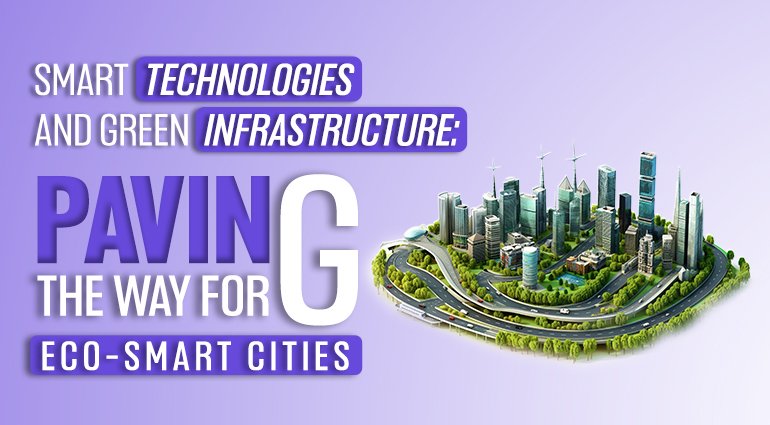Smart Technologies and Green Infrastructure: Paving the Way for Eco-Smart Cities

In an era marked by rapid urbanization and growing environmental concerns, the concept of eco-smart cities has gained prominence. These cities are designed to balance the needs of the population with sustainable practices that protect the environment. A key driver of this transformation is the integration of smart technologies and green infrastructure. In this blog, we’ll explore the synergy between these two elements and how they are paving the way for eco-smart cities.
The Road to Urbanization
The world is experiencing an unprecedented wave of urbanization. In 2007, for the first time in history, more than half of the global population resided in cities. This trend is set to continue, with urban areas projected to accommodate two-thirds of the world’s population by 2050. As cities expand and populations grow, they face numerous challenges, from congestion and pollution to resource management and climate change mitigation.
Eco-smart cities emerge as a solution to these challenges. They prioritize sustainable living and a high quality of life for residents while minimizing their ecological footprint. Two fundamental components drive this transformation: smart technologies and green infrastructure.
Smart Technologies: The Nervous System of Eco-Smart Cities
Smart technologies are the backbone of eco-smart cities. These technologies encompass a wide range of interconnected systems that collect, analyze, and utilize data to enhance urban living. Here’s how they contribute to the development of eco-smart cities:
1. Efficient Resource Management: Smart technologies enable the efficient use of resources such as energy and water. Advanced metering, automated control systems, and real-time data analysis help reduce waste and conserve precious resources.
2. Improved Mobility: Smart transportation systems, including smart traffic lights, GPS navigation, and ride-sharing apps, reduce congestion and pollution. This encourages the use of public transport and eco-friendly modes of transportation.
3. Enhanced Safety and Security: Smart city technologies bolster public safety through surveillance systems, emergency response coordination, and crime prediction models. A secure environment is essential for eco-smart living.
4. Sustainable Energy Solutions: Renewable energy sources, like solar panels and wind turbines, are integrated into the urban landscape. Smart grids manage the distribution of energy efficiently, reducing reliance on fossil fuels.
5. Waste Management and Recycling: IoT-enabled waste bins, along with data-driven collection schedules, streamline waste management. Smart sensors monitor bin levels, optimizing collection routes and reducing costs.
6. Citizen Engagement: Mobile apps and online platforms connect citizens with city authorities, allowing them to report issues, provide feedback, and participate in decision-making processes. This fosters a sense of community and shared responsibility.
Green Infrastructure: Nature in the City
Green infrastructure refers to a city’s natural and semi-natural areas, designed and managed to provide ecological, economic, and social benefits. It includes parks, green roofs, green walls, urban forests, and water management systems. Here’s how green infrastructure contributes to eco-smart cities:
1. Urban Heat Island Mitigation: Green spaces act as natural coolants, reducing the urban heat island effect. This leads to lower energy consumption for air conditioning and improved air quality.
2. Biodiversity Preservation: Urban green areas provide habitat for wildlife and support biodiversity. This not only enriches the city’s ecosystem but also provides opportunities for education and recreation.
3. Stormwater Management: Green infrastructure helps absorb and filter rainwater, reducing the strain on drainage systems and preventing flooding. This is crucial in times of climate change-induced extreme weather events.
4. Air Quality Improvement: Trees and plants help purify the air by absorbing pollutants and releasing oxygen. This enhances the overall well-being of city residents.
5. Aesthetic and Psychological Benefits: Green spaces offer mental and physical relaxation, improving the overall quality of life in urban areas.
The Synergy Between Smart Technologies and Green Infrastructure
The true magic happens when smart technologies and green infrastructure converge. When integrated seamlessly, these two elements create a powerful synergy that propels eco-smart cities forward:
1. Data-Driven Green Management: Smart technologies provide real-time data on the health and usage of green infrastructure. This information guides city planners in optimizing these spaces and ensuring their long-term viability.
2. Resource Efficiency: Data analytics enable smart management of water and energy in green infrastructure, reducing wastage and making the best use of available resources.
3. Public Awareness: Smart technologies help engage the public in the upkeep and appreciation of green infrastructure, fostering a sense of ownership and environmental stewardship.
4. Resilience: By utilizing technology to monitor green infrastructure, cities can respond to environmental changes and disturbances, ensuring the continued health and functionality of these vital components.
Conclusion
Eco-smart cities are the way of the future, offering a sustainable and high-quality lifestyle to a rapidly urbanizing world. Smart technologies and green infrastructure are the driving forces behind this transformation, working hand in hand to enhance resource management, mobility, safety, and overall well-being while preserving the environment.
As we look ahead, it is essential for city planners, policymakers, and citizens to recognize the value of this synergy and support the development of eco-smart cities. Through innovation, collaboration, and a commitment to sustainable urban living, we can pave the way to a brighter, greener future for all.



